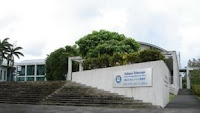 Last night, we attended the world’s only 3D stereo planetarium at the ‘Imiloa Astronomy Center in Hilo on the Big Island of Hawaii. In the 120 seat oval theater Shawn Laatsch, the planetarium director, gave us a personal tour of the universe, starting with the stars in the Hawaiian sky, zooming out to the Earth, the Moon, through the solar system, beyond one light year, (the farthest we have sent any object from earth), and then out hundreds of millions of light years from Earth. Objects in space are being charted at an astonishing rate using new telescope technologies and Astronomers are creating databases of the contents of the universe allowing us to see the objects and formations in 3 dimensions. The Big Island is rapidly rising in stature in the international Astronomy world due to the published discoveries using the world class optical telescopes on Mauna Kea’s summit and the quickly shrinking viewing opportunities from telescopes elsewhere due to light pollution. In support of the telescopes, all street lights on the Big Island have been replaced with dark sky light fixtures, the road to Mauna Kea summit has been improved, the Onizuka Center for International Astronomy provides a visitor’s center and residences at 9000 feet for Astronomers and those supporting the telescopes to access the telescopes at 14,000 feet atop Mauna Kea.
Last night, we attended the world’s only 3D stereo planetarium at the ‘Imiloa Astronomy Center in Hilo on the Big Island of Hawaii. In the 120 seat oval theater Shawn Laatsch, the planetarium director, gave us a personal tour of the universe, starting with the stars in the Hawaiian sky, zooming out to the Earth, the Moon, through the solar system, beyond one light year, (the farthest we have sent any object from earth), and then out hundreds of millions of light years from Earth. Objects in space are being charted at an astonishing rate using new telescope technologies and Astronomers are creating databases of the contents of the universe allowing us to see the objects and formations in 3 dimensions. The Big Island is rapidly rising in stature in the international Astronomy world due to the published discoveries using the world class optical telescopes on Mauna Kea’s summit and the quickly shrinking viewing opportunities from telescopes elsewhere due to light pollution. In support of the telescopes, all street lights on the Big Island have been replaced with dark sky light fixtures, the road to Mauna Kea summit has been improved, the Onizuka Center for International Astronomy provides a visitor’s center and residences at 9000 feet for Astronomers and those supporting the telescopes to access the telescopes at 14,000 feet atop Mauna Kea. It’s not just the cosmos tours of the most up to date discoveries, it’s access to Astronomers in the audience to answer any question you might have, and colloquia’s by visiting Astronomers. Tonight’s colloquia featured Dr. Mike Brown a Professor of Planetary Astronomy at Caltech who is in town waiting for the clouds to clear on Mauna Kea to get time on the Keck telescope. Dr. Brown is best known for his discovery of Eris, an object larger than Pluto and resulting in demotion of Pluto to a dwarf planet status. Keck’s optical pictures are far superior to Hubble due to its adaptive optics, drawing Dr. Brown and other prominent Astronomers to the island.
It’s not just the cosmos tours of the most up to date discoveries, it’s access to Astronomers in the audience to answer any question you might have, and colloquia’s by visiting Astronomers. Tonight’s colloquia featured Dr. Mike Brown a Professor of Planetary Astronomy at Caltech who is in town waiting for the clouds to clear on Mauna Kea to get time on the Keck telescope. Dr. Brown is best known for his discovery of Eris, an object larger than Pluto and resulting in demotion of Pluto to a dwarf planet status. Keck’s optical pictures are far superior to Hubble due to its adaptive optics, drawing Dr. Brown and other prominent Astronomers to the island. 

Hilo and nearby Waimea are headquarters for the international Gemini Observatory and Joint Astronomy Center, the Smithsonian Observatory, Japan’s Subaru Observatory, the University of Hawaii
 Observatories, the Caltech Submillimeter Array, Canada-France-Hawaii Telescope and the Keck.
Observatories, the Caltech Submillimeter Array, Canada-France-Hawaii Telescope and the Keck.The confluence of the Observatory activities and the University of Hawaii Hilo (UHH) Astronomy degree programs has resulted in a massive number of projects, grants, and activities in Hilo related to Astronomy and space travel. Hilo residents have created the AstroDay Institute and the Ellison Onizuka Space Science Day. The Hawaiian Astronomical Society and the world-class ‘Imiloa Astronomy Center provide classes and events that allow Astronomers to show off their stuff and attract a new generation of scientists drawn to the excitement in the field.
UHH hosts Pacific International Space Center for Exploration Systems (PISCES), a joint project of Japan and the US to develop technologies that enable humans to sustain life on another planet; UHH faculty and students are involved in the All-sky High Resolution Air shower (ASHRA) detector program which studies cosmic radiation; UHH is participating in the development of the Panoramic Survey Telescope and Rapid Response System (PanSTARRS) asteroid detection system. This is only a sampling of Astronomy and research happening in Hilo.
The Big Island of Hawaii is the heart of Astronomy and is fast becoming the future space research center where Hawaii’s deep understanding of surviving disasters combined with the Hawaiian culture of exploration and navigation to a new land may be keys to mankind’s success in space travel.
No comments:
Post a Comment